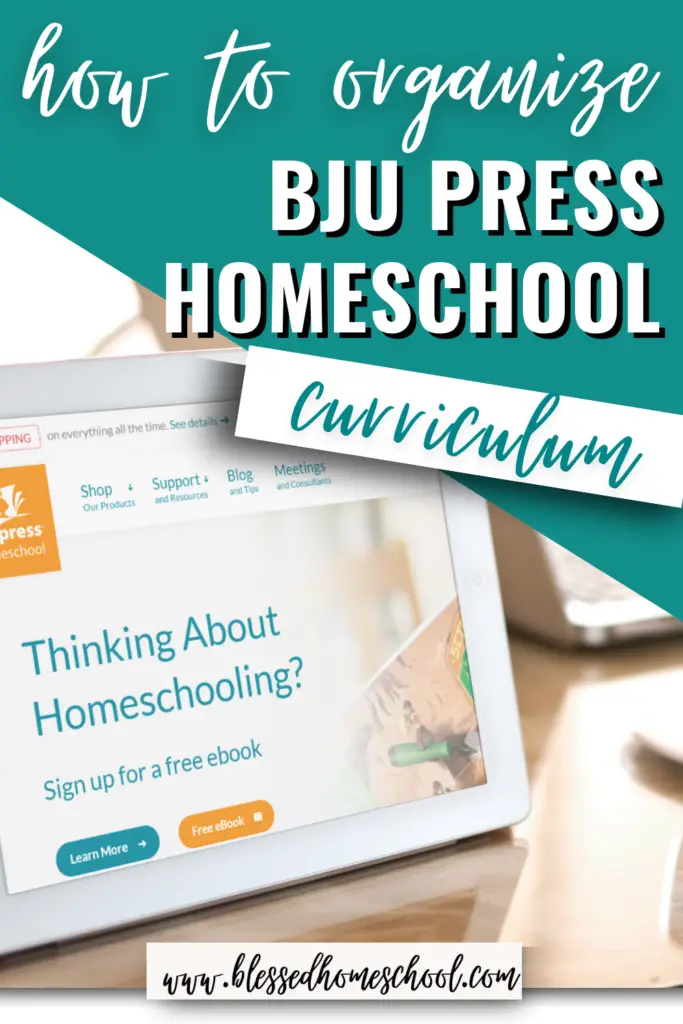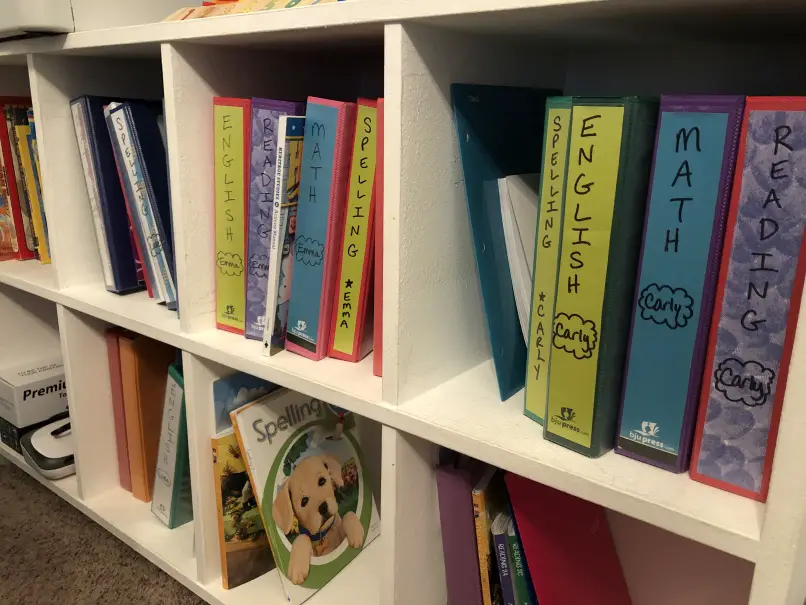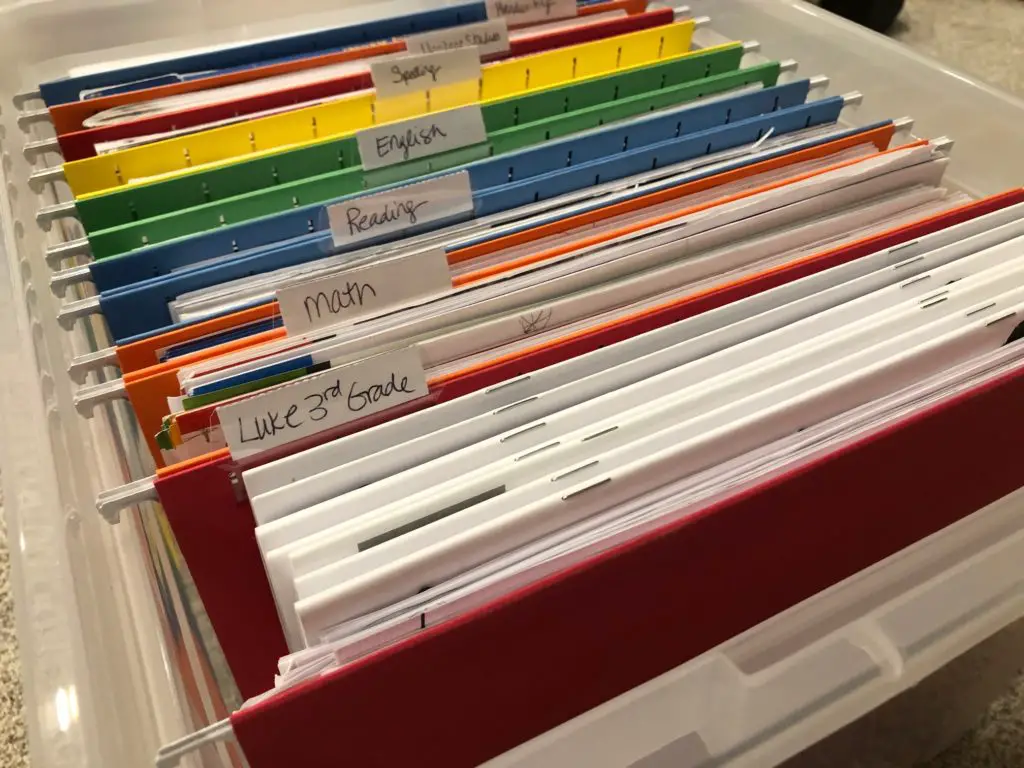How to Organize BJU Homeschool Curriculum
Just so you know, this post contains affiliate links. That means if you use them to make a purchase, I may earn a commission. You can read my full affiliate disclosure HERE.
It’s one of my favorite times of the year – getting prepped and ready for the new school season! This means new supplies, new routines, new schedules, and taking time to organize all of our BJU Homeschool curriculum for the year.
If you are using BJU Press curriculum for the first time (especially if you are using it for multiple kids, or purchased multiple subjects and resources), it can be overwhelming to receive that shipment of curriculum. I know I was overwhelmed when the boxes started rolling in with BJU Homeschool curriculum for my three school-aged kiddos!
There were boxes of books, student worktexts, tests & answer keys, and student handouts. I loved having so many resources already printed out and ready to go, but I knew I needed a good system in place to organize everything and help our homeschool run efficiently.
I’m going to share with you how I organize all of our BJU Homeschool educational materials so you can feel confident and prepared going into your school year!

What is BJU Homeschool?
BJU Homeschool (also known as Bob Jones Homeschool Curriculum) is an all-in-one K3-12 curriculum that teaches from a Christian worldview. Originally, it was created for use in a Christian school, but is now offered as a homeschooling curriculum. For homeschool families, they offer options for all grade levels of either textbook kits or video lessons that include everything you need to teach your kids.
I would say that because of it’s original use, the program definitely leans more towards traditional school, so you’ll have to evaluate your homeschool style and determine if BJU Homeschool would fit your needs. But for us, it works really well and has such high-quality content. I love having a solid, biblically-based curriculum that promotes critical thinking at my fingertips.
You can read more about why we love using Bob Jones curriculum in this post. I also wrote about a great new feature they have for their online lesson plans here.
How I organize our BJU Press homeschool curriculum
This year, I had my son using BJU Press 3rd grade materials, and my twin daughters used the 2nd grade curriculum and online courses. You may organize your curriculum in different ways depending on the grade level and materials, but I want to share what has given us great success!
Homeschool Room Organization
For starters, I have a large cubby shelf in our homeschool room. We painted an old shelf we had in storage, which is similar to this Better Homes and Gardens 8-Cube Organizer. I absolutely love it because I can separate our binders and BJU textbooks easily; this year, each of my three kids had two of the cubbies that were stacked on top of each other.
You can see from the picture that I had a binder for each subject. I bought 1.5″ binders for Math, Reading, and English (as those subjects had more printed materials), and a 1″ binder for spelling. I used only folders (no binders) for handwriting, heritage studies, and science, but looking back, I wish I would have used a small binder for those as well for organizing.

I like using binders that have clear covers you can insert a sheet into. I cut off the covers of the BJU Press student worktext books for each subject to use for labeling the binders.
Organizing BJU Homeschool Binders
Below is an example of how I organized each of the subject binders (this was my son’s 3rd grade math binder). We used the BJU Press Distance Learning Online option for our core subjects, so inside the front cover I stuck the class schedule that comes with the course.
You’ll notice that next, I put all of the student handouts for BJU Press math on top of everything else in the binder:


If you flip past all of the student handouts (see below pic), I have a divider in there with pockets. I like using sturdy dividers like these. Having a pocket was helpful because I would store completed tests in them. You could also use it to keep any other math printables or papers that you add into the curriculum to supplement (if you do this!).
After the divider, I put the student worktext pages. These sheets come in a book, but I tore them all out so I could store them in the math binder. This way, everything was all in one place, and easy for my son to grab each day when he was ready to work.
You could certainly keep all the sheets IN the worktext and stick it in the same place in the binder; each day you would just have to take out the worktext book and tear out the sheets you need.
Finally, you’ll see one more divider after the worktext pages. This is where all of the completed work goes at the end of the day.



So for example, each day when my son logged in to BJU Homeschool Online, he would get a list of materials he needed for the day. He’d go to his binder, pull out any handouts needed from the front, grab the corresponding worktext pages, and then go to town with the lesson. When he was finished, I’d check everything (and go over the lesson with him as needed), then file the completed work in the back of the binder. Easy for me – and everything is all in one place, so it’s easy for him, too!
Organizing Tests and Answer Keys
Our BJU Homeschool package also came with tests and answer keys for each subject (these are optional items you can add-on). I bought two extra binders for these: one for all 3rd grade tests and keys, and another one for all 2nd grade tests and keys.
You can take a look at my test binders below. I put all of the Video Lesson Guides at the beginning of the binder in case I needed them (in reality – I really never did, as we followed the schedule online). But then I gave each subject it’s own divider folder. All of the blank tests went in the folders until I was ready to use them, and then I put the answer keys in the binder behind the tests:



Once my kids finished a test, I stored it in the subject-specific binder, or in their homeschool portfolio folder.
Organizing Your Homeschool Portfolio
This is a little tip that I didn’t think of until the end of the school year; and once I did, I wish I would have done it from the beginning! So I’m sharing it with you now as a little pro-organizing tip that will help cleaning everything up at the end of the school year a breeze.
I definitely have a tendency to hang on to everything – even though I know I don’t really need to. So this might seem excessive to you…but if you’re anything like me, it will be helpful!
I bought a plastic file box and created a folder for each of my kids as their main “portfolio” folder. This is going to be the space where I store their homeschool portfolio documents, end-of-the-year grades and records, a report card, my homeschool hours log, etc. Basically, helping me keep track of student records throughout the year.

But I am also going to use this folder to stash away all of their “best work” pieces my kids complete for their portfolio as they finish them. I didn’t do this last year, and at the end of the year I was rifling through so many papers for artifacts that showed their best work and their learning progress over the year. Having a space to file those away separately as they are completed is going to be a big time saver!
Then, at the end of the year, I created a new file folder for each subject and put it in the bin behind the portfolio folder (see below pic). In each folder, I stored most of the printed work that was completed over the year. Depending on how much you want to save, you might use one entire bin per child, or you might be able to use one bin for each separate school year. That will be up to you!

I figure that I’ll hold on to all of the work for about 3 years or so, and then I’ll start to get rid of the excess – but I’ll keep the portfolio folders for each year for my kids.
What supplies do you need to organize BJU Homeschool curriculum?
I hope that gives you an idea of how I organize my BJU Homeschool materials, and how you might be able to organize yours to. It’s so nice to have a system in place that helps our homeschool days run smoothly!
Here are some of the supplies and resources we use to organize our homeschool curriculum that you might like to have on hand:
- Computers or tablets. Since we used BJU Press DLO, it was very helpful for us to have something for each of our kids to access their video instruction on. We purchased these computers for our kids and have been very happy with them!
- Headphones. Along with the computers, headphones were nice so our kids could listen to lessons without bothering each other!
- Homeschool checklists. I put this homeschool checklist on a clipboard for my kids each week so they had an easy reference to see what they needed to accomplish each day. You can read more about how I used the checklists here. I will add that once BJU Press rolled out the Homeschool Hub, we utilize that online system so much more for checking off daily work.
- Storage bins and file folders for storing portfolios and student work
- Binders for storing worktext and worksheet pages
- Tab dividers for your binders
Where can I purchase BJU Homeschool?
If you are interested in checking out BJU curriculum, you can learn more about them and browse their curriculum here. Whether you are using it as a full curriculum, or just parts of it, they offer a variety of options to help best suit your homeschooling needs, along with monthly installments for payments if needed.
Do you have any other tips for how you organize your BJU Homeschool materials to help out other homeschooling parents? Drop a note in the comments below!

Related Posts
- Practical Homeschool Organization Tips for Moms Who Can’t Stand Clutter
- How to Decide Which Homeschool Curriculum is Right For You
- Win at Homeschooling This Year – Simple Advice to Follow



